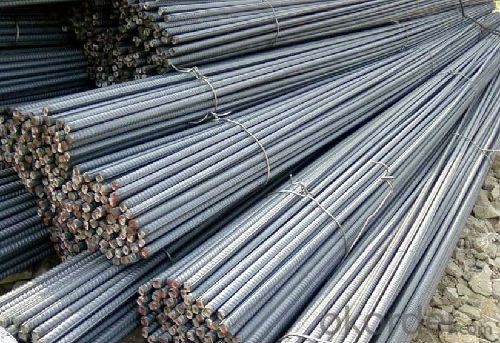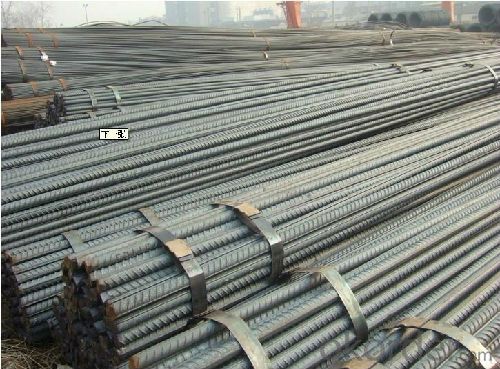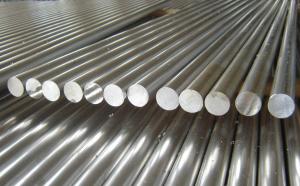Deformed Bar HRB500 HRB400 High Quality Hot Rolled 6mm-50mm BS4449
- Loading Port:
- China Main Port
- Payment Terms:
- TT or LC
- Min Order Qty:
- -
- Supply Capability:
- -
OKorder Service Pledge
OKorder Financial Service
You Might Also Like
Product Description:
OKorder is offering high quality Hot Rolled Steel I-Beams at great prices with worldwide shipping. Our supplier is a world-class manufacturer of steel, with our products utilized the world over. OKorder annually supplies products to European, North American and Asian markets. We provide quotations within 24 hours of receiving an inquiry and guarantee competitive prices.
Product Applications:
Deformed bar is widely used in buildings, bridges, roads and other engineering construction. Big to highways, railways, bridges, culverts, tunnels, public facilities such as flood control, dam, small to housing construction, beam, column, wall and the foundation of the plate, deformed bar is an integral structure material. With the development of world economy and the vigorous development of infrastructure construction, real estate, the demand for deformed bar will be larger and larger
Product Advantages:
OKorder's Steel I-Beams are durable, strong, and resist corrosion, exact size, regular package, chemical and mechanical properties are stable.
Main Product Features:
· Premium quality
· Prompt delivery & seaworthy packing (30 days after receiving deposit)
· Corrosion resistance
· Can be recycled and reused
· Mill test certification
· Professional Service
· Competitive pricing
Product Specifications:
Manufacture: Hot rolled
Grade: BS4449
Certificates: ISO, SGS, BV, CIQ
Diameter: 6mm,8mm,10mm,12mm,14mm,16mm,18mm,20mm,
22mm,25mm,28mm,32mm,36mm,40mm,50mm
Length: 6M, 9M,12M or as required
Packaging: Export packing, nude packing, bundled
Chemical Composition: (Please kindly find our chemistry of our material based on HRB500 as below for your information)
Grade | Technical data of the original chemical composition (%) | ||||||
C | Mn | Si | S | P | V | ||
HRB400 | ≤0.25 | ≤1.60 | ≤0.80 | ≤0.045 | ≤0.045 | 0.04-0.12 | |
Physical capability | |||||||
Yield Strength (N/cm²) | Tensile Strength (N/cm²) | Elongation (%) | |||||
≥400 | ≥570 | ≥14 | |||||
Theoretical weight and section area of each diameter as below for your information:
Diameter(mm) | Section area (mm²) | Mass(kg/m) | Weight of 12m bar(kg) |
6 | 28.27 | 0.222 | 2.664 |
8 | 50.27 | 0.395 | 4.74 |
10 | 78.54 | 0.617 | 7.404 |
12 | 113.1 | 0.888 | 10.656 |
14 | 153.9 | 1.21 | 14.52 |
16 | 201.1 | 1.58 | 18.96 |
18 | 254.5 | 2.00 | 24 |
20 | 314.2 | 2.47 | 29.64 |
22 | 380.1 | 2.98 | 35.76 |
25 | 490.9 | 3.85 | 46.2 |
28 | 615.8 | 4.83 | 57.96 |
32 | 804.2 | 6.31 | 75.72 |
36 | 1018 | 7.99 | 98.88 |
40 | 1257 | 9.87 | 118.44 |
50 | 1964 | 15.42 | 185.04 |
FAQ:
Q1: How soon can we receive the product after purchase?
A1: Within three days of placing an order, we will begin production. The specific shipping date is dependent upon international and government factors, but is typically 7 to 10 workdays.
Q2: What makes stainless steel stainless?
A2: Stainless steel must contain at least 10.5 % chromium. It is this element that reacts with the oxygen in the air to form a complex chrome-oxide surface layer that is invisible but strong enough to prevent further oxygen from "staining" (rusting) the surface. Higher levels of chromium and the addition of other alloying elements such as nickel and molybdenum enhance this surface layer and improve the corrosion resistance of the stainless material.
Q3: Can stainless steel rust?
A3: Stainless does not "rust" as you think of regular steel rusting with a red oxide on the surface that flakes off. If you see red rust it is probably due to some iron particles that have contaminated the surface of the stainless steel and it is these iron particles that are rusting. Look at the source of the rusting and see if you can remove it from the surface.


- Q:How do steel rebars affect the overall structural integrity of a building?
- The overall structural integrity of a building is greatly enhanced by steel rebars. These rebars provide reinforcement and strength to the concrete, making it more durable and resistant to external forces. To begin with, the role of steel rebars in reinforced concrete structures is that of tension members. While concrete itself is strong in compression, it lacks strength in tension. By embedding steel rebars within the concrete, the composite material becomes capable of withstanding tensile forces without cracking or failing. This ensures that the building can endure the tensile stresses caused by factors like wind load, seismic activity, and ground settlement. Additionally, steel rebars aid in the even distribution and dissipation of loads throughout the structure. They enhance the load-bearing capacity of the concrete, enabling it to withstand heavier loads and prevent crack formation. Moreover, the rebars help control the spread of cracks resulting from shrinkage or thermal expansion, thereby averting catastrophic failure. Moreover, the inclusion of steel rebars enhances the ductility of the reinforced concrete structure. Ductility refers to a material's ability to deform under stress before breaking. By incorporating steel rebars, the concrete gains the capacity to bend and stretch without losing its strength. This is particularly crucial in earthquake-prone areas, as the building can absorb and dissipate the energy generated by seismic forces. Furthermore, steel rebars contribute to the durability and longevity of the building. They safeguard the concrete by preventing corrosion and degradation. When properly coated and installed, rebars act as a barrier against moisture and other corrosive elements, thereby preserving the building's structural integrity over time. In conclusion, the impact of steel rebars on the overall structural integrity of a building is significant. They reinforce the concrete, enhance its load-bearing capacity, improve ductility, and increase durability. Incorporating steel rebars into construction ensures that the building can withstand various external forces and maintain its stability and safety for an extended period.
- Q:How are steel rebars measured and priced in the market?
- Steel rebars are typically measured and priced in the market based on their weight per linear foot or meter. The weight is usually expressed in pounds or kilograms. The pricing is influenced by factors such as the current cost of steel, market demand, and any additional processing or transportation costs.
- Q:What is the role of steel rebars in reducing concrete creep?
- Concrete creep, the gradual deformation of concrete over time under sustained loading, is significantly reduced by the incorporation of steel rebars. These high-strength reinforcement bars enhance the structural integrity and durability of concrete structures by providing tensile strength to counteract the forces that cause creep. Under sustained loads, concrete experiences internal stresses that can lead to creep. However, the presence of steel rebars helps distribute these stresses more evenly throughout the structure, acting as reinforcement to absorb and redistribute the tensile forces and minimize concrete deformation. Additionally, steel rebars improve the bond between concrete and reinforcement, ensuring they work together as a composite material. This bond prevents the formation of cracks, which can contribute to creep. Moreover, steel rebars enhance the overall stiffness and rigidity of concrete structures, resisting the deformation caused by creep and maintaining stability over time. In conclusion, steel rebars play a crucial role in reducing concrete creep by providing tensile strength, distributing internal stresses, improving the bond between concrete and reinforcement, and enhancing overall stiffness. Engineers can effectively mitigate the effects of creep and ensure long-term performance and durability by incorporating steel rebars into concrete structures.
- Q:Can steel rebars be used in modular bridges?
- Yes, steel rebars can be used in modular bridges. Steel rebars are commonly used in the construction of bridges due to their strength, durability, and ability to handle heavy loads. They provide reinforcement to the concrete components of the bridge, ensuring its structural integrity. In modular bridge construction, steel rebars are often incorporated into precast concrete elements, allowing for efficient and cost-effective assembly of the bridge modules.
- Q:What is the effect of impurities on the corrosion resistance of steel rebars?
- Impurities in steel rebars can have a negative impact on their corrosion resistance. These impurities, such as sulfur, phosphorus, and certain non-metallic inclusions, can promote the formation of localized corrosion sites and accelerate the corrosion process. Additionally, impurities can weaken the protective oxide layer on the surface of the steel, making it more susceptible to corrosion. Therefore, minimizing impurities in steel rebars is crucial to ensure their long-term corrosion resistance and structural integrity.
- Q:Are steel rebars suitable for reinforcement in swimming pools?
- Yes, steel rebars are suitable for reinforcement in swimming pools.
- Q:What are the potential drawbacks of using steel rebars?
- One potential drawback of using steel rebars is the risk of corrosion. Steel is susceptible to rust and corrosion when exposed to moisture and chemicals, which can weaken the rebars over time and compromise the structural integrity of the reinforced concrete. To mitigate this drawback, proper protective coatings and maintenance are required. Additionally, steel rebars are heavy and may require specialized equipment for handling and installation, which can add to the overall construction costs.
- Q:What is the average lifespan of steel rebars in marine environments?
- The average lifespan of steel rebars in marine environments varies depending on several factors such as the quality of the steel, level of exposure to saltwater and other corrosive elements, maintenance practices, and design considerations. However, with proper corrosion protection measures and regular maintenance, steel rebars in marine environments can typically last around 30 to 50 years.
- Q:How do steel rebars affect the seismic performance of a structure?
- Steel rebars have a significant impact on the seismic performance of a structure. The primary role of steel rebars is to reinforce concrete and enhance its strength and ductility. This reinforcement plays a crucial role in mitigating the damaging effects of seismic activity. During an earthquake, a structure experiences various forces, such as lateral forces, shear forces, and bending moments. These forces can cause the structure to deform, crack, or even collapse. However, steel rebars provide resistance against these forces and help maintain the integrity of the structure. The presence of steel rebars increases the tensile strength of concrete, which is otherwise weak in tension. This enhanced tensile strength allows the structure to better withstand the lateral movement induced by seismic waves. By distributing the forces more evenly, the rebars help to reduce the formation and propagation of cracks, limiting the potential for structural failure. Moreover, steel rebars increase the ductility of the structure. Ductility refers to the ability of a material to undergo deformation without breaking. During an earthquake, the ground shaking can cause the structure to deform and oscillate. Steel rebars allow the structure to absorb and dissipate energy, reducing the likelihood of sudden failure. This ductile behavior is crucial in earthquake-prone regions as it provides warning signs of potential structural distress, allowing occupants to evacuate safely. Furthermore, steel rebars can be strategically placed in critical areas of a structure, such as the beam-column joints, which are highly vulnerable during seismic events. The proper detailing and configuration of rebars in these areas can significantly improve the seismic performance by strengthening the connections and preventing premature failure. In summary, steel rebars play a crucial role in enhancing the seismic performance of a structure. They increase the tensile strength of concrete, improve ductility, reduce crack formation, and strengthen critical areas. These factors collectively contribute to a more resilient structure that can better withstand and absorb the forces generated during an earthquake, ultimately ensuring the safety and stability of the building and its occupants.
- Q:How do steel rebars contribute to the load-bearing capacity of concrete slabs?
- The load-bearing capacity of concrete slabs is improved through various mechanisms by steel rebars. Firstly, they increase the tensile strength of the concrete. While concrete is renowned for its compressive strength, it lacks the ability to resist tensile forces. By incorporating steel rebars into the concrete, a reinforced structure is formed, capable of withstanding both compressive and tensile stresses. This effectively prevents the concrete from cracking or failing when subjected to heavy loads. Secondly, steel rebars aid in the even distribution of loads across the concrete slab. When a load is applied to the slab, it tends to concentrate at specific points, leading to stress concentrations. However, the presence of rebars facilitates the spreading of the load over a larger area, reducing stress on individual points and enhancing the overall load-bearing capacity of the slab. Additionally, steel rebars serve as a barrier against crack propagation in concrete slabs. If a crack occurs, the rebars act as reinforcement, holding the cracked sections together and preventing the crack from expanding further. This ensures the structural integrity of the slab is maintained, safeguarding its load-bearing capacity. In conclusion, steel rebars are indispensable in bolstering the load-bearing capacity of concrete slabs. They provide tensile strength, ensure even load distribution, and inhibit crack propagation. By incorporating rebars, the durability and ability of concrete structures to withstand heavy loads are significantly improved, making them indispensable components in construction projects.
1. Manufacturer Overview |
|
|---|---|
| Location | |
| Year Established | |
| Annual Output Value | |
| Main Markets | |
| Company Certifications | |
2. Manufacturer Certificates |
|
|---|---|
| a) Certification Name | |
| Range | |
| Reference | |
| Validity Period | |
3. Manufacturer Capability |
|
|---|---|
| a)Trade Capacity | |
| Nearest Port | |
| Export Percentage | |
| No.of Employees in Trade Department | |
| Language Spoken: | |
| b)Factory Information | |
| Factory Size: | |
| No. of Production Lines | |
| Contract Manufacturing | |
| Product Price Range | |
Send your message to us
Deformed Bar HRB500 HRB400 High Quality Hot Rolled 6mm-50mm BS4449
- Loading Port:
- China Main Port
- Payment Terms:
- TT or LC
- Min Order Qty:
- -
- Supply Capability:
- -
OKorder Service Pledge
OKorder Financial Service
Similar products
New products
Hot products
Related keywords






























